Testifying to the past glory of
Mongolia and bringing not just the Mongolian history but also the collective past of the entire Central Asia together, the National Museum of Mongolia is a one stop destination for quick historical recap.
The National Museum, established in 1991, shows the transformational journey of the country from socialism towards an open market economy, and merges the relics of the past glory of the Museum of revolution with the new and more dynamic changes to converge into a more united entity that defines the new Mongolia.
The museum holds over 50,000 historical and ethnographical objects till this date and proudly showcases the culture of the country that dates from 800000 BCE to the end of the 20th century. There is a lot to see and learn here so make sure that you read a bit about before visiting this magnificent spot.
How to Reach the National Museum?
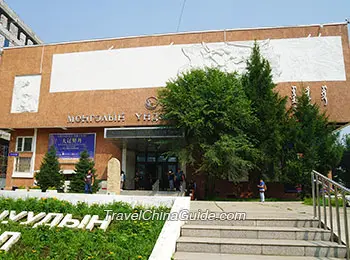 |
• You can take a taxi, there are two types of taxi services, a private and another with Taxi written on it.
• Taxis are cheap, charging around T800 per kilometer (0.6miles), however, foreigners can expect to be overcharged.
• Very few divers speak in English so have the name and destination written down in Mongolian.
• The EasyRide phone App service will help Android and iPhone customers with fair charges and English drivers to the destination they wish to go.
• Buses are unreliable and can delay travel plans unless you keep a good amount of time in hand. The buses have fixed charges of T500 per ride. Electric trolly buses charge a bit less but are T300 but are slower and run on fewer routes. All you need is to get a Bus Card made which can be purchased from any Bus Stop or stores and kiosks. Be exact with payment as no change is returned on higher denomination bills.
• Walking is an option but might be puzzling for firsts timer. You can use the GPS or purchase a map from the airport.
See more about Mongolia Transportation
Location and What to Expect
Located in Juulchin Street -1, Ulaanbaatar, the museum is 4.6 km (almost 3 miles) away from the city center Mongolia and it remains open all seven days of the week from 9.00 am – 6.00 pm. For taking photographs you need to pay 10,000 MNT at the entrance. You can also ask for an audio guide at the main entrance.
If history interests you, then this will surely be worth a visit. Spend as much time as you can to visit the three areas archaeological; medieval history of Mongolia; and modern historical objects of the museum.
Most people love to spend time in the ethnographical collection which is subdivided into jewelry and accessories section; costumes; musical instruments; kitchen tools; Mongolian gear and furnishings; animal husbandry equipment; and religious items relating to Shamanism and Buddhism have influenced many artists of today.
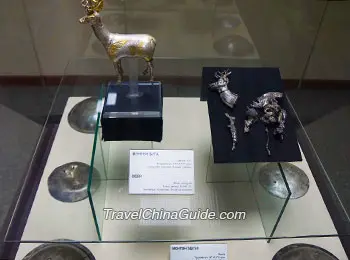 | | Deer Stone | | 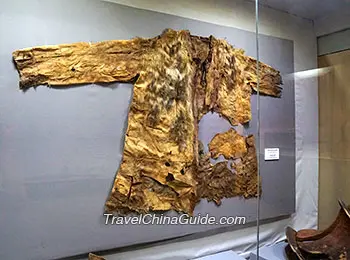 | | Mongolian Traditional Clothes | |
Walking Down the Museum
Scattered with treasures from Hun and Uighur eras, the first floor of the National Museum of Mongolia exhibits Mongolia’s specimens from the Stone Age sites. Stone tools are the oldest prehistoric artefacts in Mongolia found in Tsagaan agui or White Cave in Bayanhongor aimag. The burial grounds of the Hun and Uighur eras are also of significant interest.
The Deer Stone and Significant Prehistoric Pieces
In the middle of the first hall you will spot a replica of the Deer Stone recreated by the Museum archaeologists made in 2004 from the original at the Uushigiin uvur, Burentogtokh sum, Khuvsgul aimag. This monument is a specimen from the late Bronze and Early Iron Ages. Almost 100 years ago a total of 900 Dear stones had been found which is about ninety per cent of the monuments said to be in and around Magnolia.
These stones are well cut oblong and the surface area of the stones are divided into three horizontal bands divided into three sections that reflect nature, the deer and their hunting equipment. Some deer stones are crowned with human heads and faces.
Ethnographical Collection
A golden crown from the Turkic period, 7th century holding precious stones has a phoenix, the mythical firebird inlaid with precious stones is quite a spectacle in the museum.
Other articles worth watching is a Deer-shaped silver ornament also from the Turkish period. The intricacies on the deer with crafty antlers, engraved floral patterns all over the body, and the large lifelike eyes speak volumes on the craftsmanship of the times.
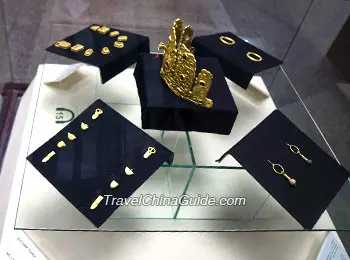 | | Golden Crown with A Phoenix | | 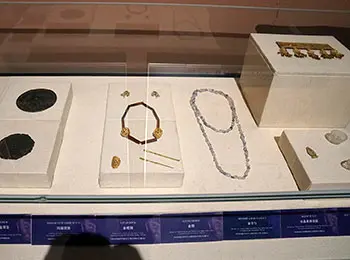 | | Jewelry And Accessories | |
Kultegin’s (Turkic prince & military general) statue’s head, broken in two pieces and a statue piece of his wife’s face, bird featured on the front of his crown, are evidence of the brilliance in sculpting. The thick lips and the gentle expression lend much depth to his persona.
Coming to the section that displays the Mongolian traditional clothes & jewelry, you cannot miss the ceremonial attire, seasonal dress, jewelry and accessories of 20 ethnic groups comprising both Mongolian and Turkish communities dating from 19th or 20th century.
The Uzemchin married woman’s headdress is the typical Mongolian stone beaded intricacy. Silver, coral, amber, turquoise and lapis lazuli ’Shuren tatuurga’ or coral are all tastefully kitted together. Eleven silver plaques are fitted on the black cotton headband and brightly decorated with red coral beads and yellow colored enamels, turquoise, lapis blue, and amber. Just below the headband two intricate network of small coral, silver, and turquoise beads lend a fine distinction to the head attire.
Medieval Mongolia
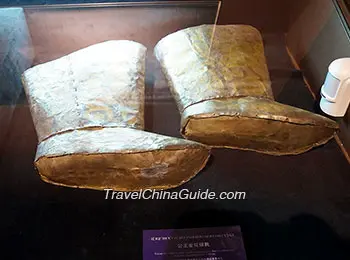 |
| Golden Boots with Embroidery |
The characteristic upturned toe boots that are still common among the Mongols are made of brown and green leather. The boots have an ulzii pattern that symbolizes longevity. The number pattern of these boots are significant 8, 12, 14, 16 or 32. These boots that come in zuu orooh (embroidery) are meant for kings and queens.
All these treasures are evidence of the Mongolian conquest in the 13th and 14th centuries. More than fifty countries, from Siberia to South Asia, from the Korean Peninsula to Bulgaria were under their influence. The exhibition hall in the National Museum of Mongolia showcases the Great Mongolian State 1206 - 1260 and the Mongolian Empire. Golden Horde State, Tsagadai Khanate, Il Khanate and the Yuan Dynast and the ancient capital of Karakorum. Displaying battle equipment like armor and ceremonial banners and illustration of 300 historical, cultural objects including portraits of Genghis Khan, Ogodei Khan and Khubilai Khan. can be seen at the end of the hall.
The Chinese inscriptions on the Khugshin Teel monument portrays the facts behind building of a fortified city by Khubilai Khan’s soldiers. This is the same period when Khubilai and Arigbuh trying to establish their kingship. Celebrating the fifteen years of the Yuan Dynasty of Khubilai Khan a foundation date for the castle was assigned in 1275.
A letter sent to Louis Philippe, King of France in 1304 -1305 from the Ulziit Sultan of IL Khanate is on display, informing him about quashing internal conflicts and establishing internal peace and extending peaceful ties towards foreign intruders.
Fresco of Zonhov Bogd Zonhov (1357-1419) He was one of the greatest lamas of Tibet and founder of the Gelug order of Buddhism. An ornate Prayer wheel, delicately carved silver incense burner, bell and thunderbolt symbols of union of wisdom and compassion, from Buddhist preaching are a part of Mongolian homes and is on display in the National Museum of Mongolia.
Musical, Games, and Other Objects
Traditional musical instruments like the horsehead fiddle, wan-head fiddles, lion-headed fiddles and dragon-head fiddles can be spotted in the National Mongolian museum. The Ikhel, a pair of strings made from horse tail hair and is played with a bow. The drum is painted brightly in vibrant hues and is struck with two drumsticks on both of its sides.
Traditional games like the wooden puzzle, the Uichuur is a game comprising 128 long, thin wooden or bone pieces. Each piece is carved depicting an animal such as a lion, tiger, deer, rabbit or bird and number assigned. It is dice game where the players collect points as they play.
Ornate seals in the National Museum of Mongolia made of silver and gilded steel carry the name of the ruler and is decorated with various flora and fauna motifs.
The Mongolian nomadic culture leaves a strong impression in their way of life. Mostly suited for nomadic animal husbandry & hunting, they cultivated and engaged in fishing & developed specific handicrafts. With the Buddhist influence a part of the population became settlers and built monasteries. The nomadic way of life was still prevalent among the rest. You can spot harness carts, Tohosh - Camel saddle Felt, cloth and skin, woolen saddle cover, woven carpet decorate the saddlebow, sideboard and seat with bone, brass, copper, silver and also gilded silver.
Impressions of Modern Mongolia
In the beginning of the 20th century Mongolia was struggling for its independence from Manchu rule and finally attained independence in 1911 under the theocratic monarchy headed by Bogd Khan and help of the communist Russia. The Erdeniin Ochir, Mongolian Order of State made of gold and precious stones established the connection between Russia and Mongolia. A typewriter with the old Mongolian script was used in Mongolia after 1928 in this period is also on display.
When in the late 1980’s the Soviet Union went through fundamental political changes (Perestroika), the outfall of the same was felt in Mongolia and photos of the protests can be found in this section depicting the formation of different political groups. Also, the first political hunger strike attended by 90,000 people in Sukhbaatar Square, Ulaanbaatar (7 March 1990) finds place on the walls of the National Museum of Mongolia.
The artifacts, exhibits, traditional costumes, history of Mongolia in chronological order can take more than a day. So, it is a good idea to schedule your time and decide on the areas that you wish to spend more time. The National Museum of Mongolia will be one of the most gratifying part of your tour.
- Last updated on Aug. 13, 2025 by Gabby Li -





